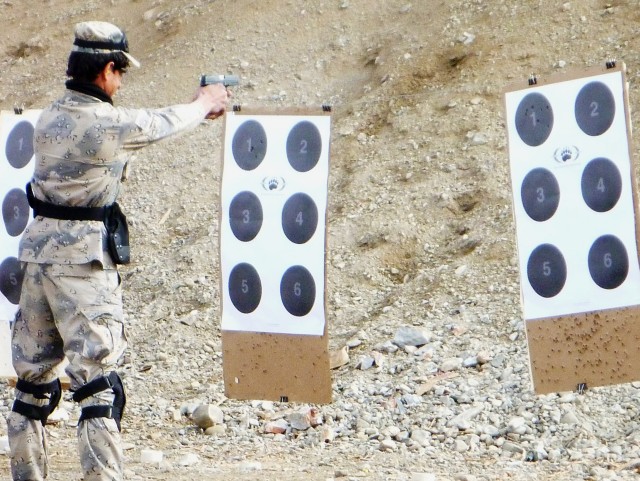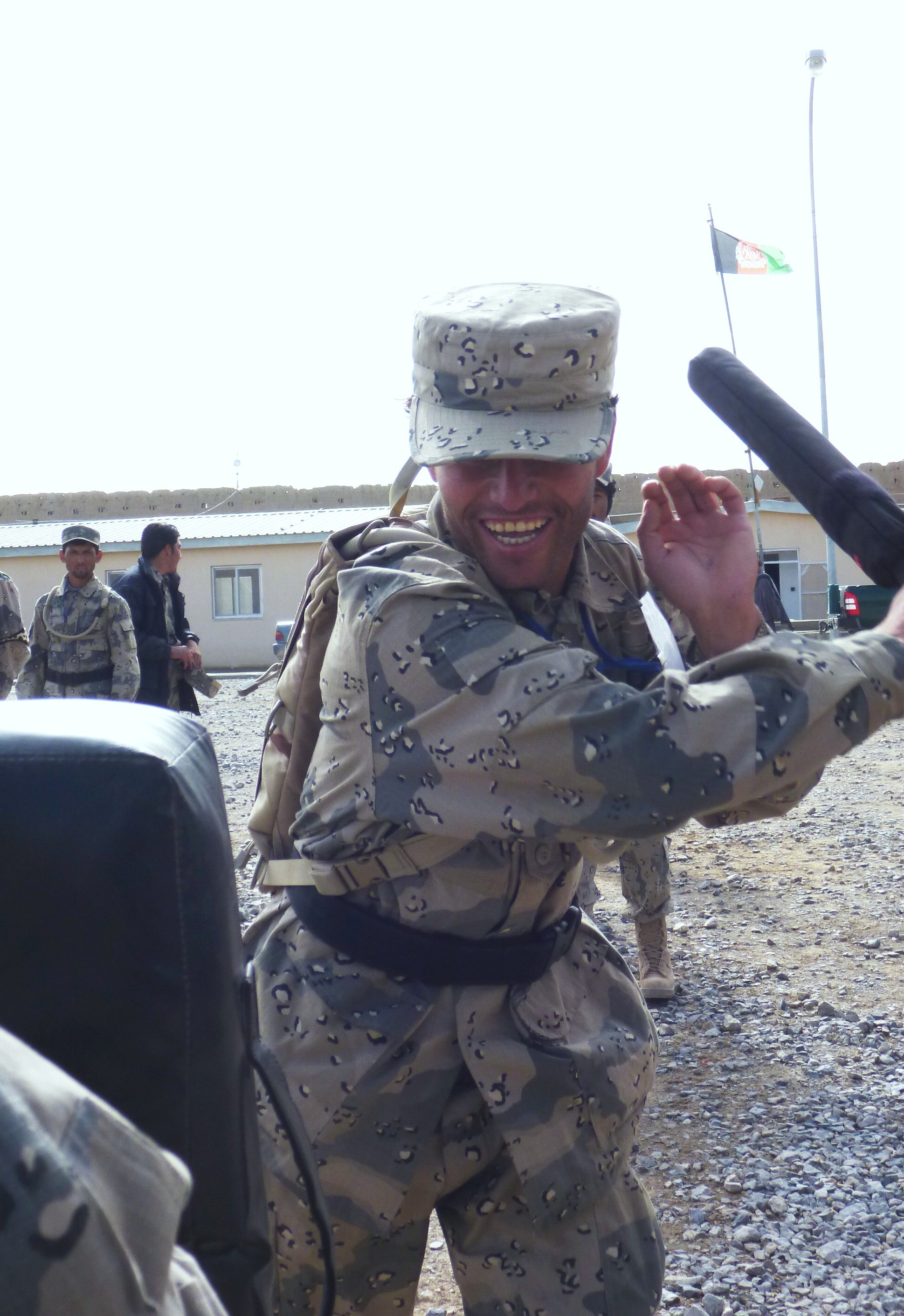KANDAHAR AIRFIELD, Afghanistan - The leadership of Deputy Commander, Regional Support, NATO Training Mission-Afghanistan and Combined Security Transition Command - Afghanistan, conducted a "battlefield circulation" or BFC Feb. 7-11 of the Regional Support Command-South area, headquartered at Kandahar Airfield.
Leading the site inspections was Brig. Gen. John J. McGuiness, assisted by incoming DCOM-RS, Brig. Gen. Guy T. Cosentino, and DCOM-RS Command Sgt. Maj. David J. Vincent.
The southern region is one of six Regional Support Commands throughout Afghanistan. It is commanded by Col. Greg Baine. Assisting him on the site visits was Sgt. Maj. Carl Fagan. The RSCs serve to facilitate contracting, training, and construction to support the Afghan National Security Forces.
The purpose of a "BFC" to see how progress is coming regarding the training and conditions for Afghan National Security Force personnel. And, to determine if needs are being met regarding contracts for training facilities and living quarters.
Upon landing at KAF, grounding gear at billeting, and then some chow, the DCOM-RS and RSC-S group ventured out to the Regional Military Training Center-South to observe training.
There to show them around was Capt. David Chapman, a coalition senior adviser for Basic Warrior Training or BWT.
"They cover down as well as Americans," said Cosentino as the group watched Afghan recruits line up in formation. "They look pretty impressive."
Chapman explained many of the recruits have never seen a shower, restroom, nor received vaccinations in their lives.
Sgt. 1st Class Jay Bogle, also a senior adviser, told the group that instruction on how to take apart, assemble, and perform a functions check on the M-16 rifle is now being done in small groups of up to 12 recruits. This type of training is now "down to a manageable level," he said, because all recruits are now visually closer to the training versus standing in the back of a platoon-sized formation.
After watching some literacy training going on with another group of Afghan soldiers who had completed the BWT, the group visited a tent where an eight-week medical course was underway taught by Spc. Abby Scroggins, lead senior medical mentor.
"I used to be a teacher before this," Scroggins said, adding she taught kindergarten and pre-kindergarten.
This particular medical course has 70 students comprised of 53 Afghan National Army, 14 Afghan National Civil Order Police, and three from the Afghan Air Force.
Scroggins said that she has assistant instructors who speak both Pashtun and Dari - the two most common languages in Afghanistan - to accommodate the language difference between the students.
"They love to perform," she said of the students, especially on the new trauma mannequins.
The next stop was the Improvised Explosive Device training area.
There to meet the group was Earl Wilson, a contracted instructor.
In the training area were a variety of IEDs used by the insurgency that fortunately were discovered and disarmed. Items like a pack of cigarettes and flip flops and other "every day" things are used to camouflage IEDs used against coalition forces and innocent Afghan people, Wilson said.
"Stuff that we see, we don't thinking nothing of," when we leave the wire, Wilson said, referring to the area outside of coalition control. But "it could be something."
Even something like discarded military batteries can be used by insurgents as it only takes "1.5 volts" to detonate a bomb, Wilson said.
Wilson said he was a former 11B or infantryman Soldier and has been in Kandahar five years instructing.
Part of the course also delves in clearing roads where Afghan forces are taught to scan 5 meters and clear an area, and then out to 25 meters in areas considered as vulnerable.
From here, the DCOM-RS group went to a where range basic rifle marksmanship training was conducted at a 25-meter target that simulated in size what a 250-meter target looks like.
The training included shot grouping, zeroing the weapon, and then qualifying by hitting the target at least 20 times with 30 rounds within the circle on the target with an M-16 rifle.
"These are his friends," said Cosentino to a small group of Afghans talking to a trainee after a break in firing through an interpreter. "But that's his best friend," he said of the rifle.
From here it was over to the Up-Armored Humvee Light Tactical Vehicle course which can last up to eight weeks. It is here where driving is taught, as well as preventive maintenance check and services, and such things as ground guiding a vehicle.
Besides the Humvee, another vehicle used by the Afghan National Police is the Ford Ranger pickup truck.
Sgt. Alan Donis, course noncommissioned officer-in-charge, said that handbooks with pictures are given to students to keep. "We give them the basics and the advanced training they get at their unit," he said.
Because most of the students have never driven, they receive hands-on training out in the desert area where they are taught how to drive in reverse, hand and arm signals, and just overall driving.
Donis said the biggest challenge in the course is that "there's no order when it comes to driving. We try to teach them rules of the road, enforce courtesy, speed, and distance."
As Donis points out, "Some of these guys have never seen a vehicle before."
The final movement of the day was to the 2nd Forward Supply Depot at Camp Shir Zai to visit with Col. Mirahmad Girbiz, depot commander, and then receive a tour of the facility.
"Thank you very much for visiting us again," Amir told McGuiness and the group in an initial office call. "The FSD is a big depot, almost a zone depot."
Amir said his biggest issue right now was manning. He has 35 personnel to run the FSD but is authorized 53, he said. "Hopefully, it will be fielded soon. There's a lot of work to be done here," he said through an interpreter.
The meeting dealt on such topics of medical supplies, explosives, literacy training of personnel, computer courses to automate supply inventory, and physical conditions of the depot itself, such as the request for more gravel.
During the walking tour of several warehouses, Amir said he had plenty of dry food and other rations, and diesel/petroleum, but expressed concern on the not obtaining enough uniformed jackets.
DAY 2
On this day, the group flew out to Spin Boldak (Kodiak) training area where the basic training for the Afghan Border Police Basic Course and the ABP Noncommissioned Officer course are taught. The basic course had 150 recruits in this cycle and lasts six weeks.
With the group today was Brig. Gen. Bruce Scott, deputy commanding general, Force Development, Regional Command-South, of the Australian Army.
Spin Boldak is a historic fortress site, quite unique physically with its tall, thick walls made of mud-brick with a number of carved out shooting areas protecting and encasing several training areas and the compound. It has a rich history and was constructed beginning in 1880 and completed in 1901. It is a symbol of Afghan sovereignty in the region near the border of Pakistan, which was British India in that era.
The group also went to a nearby 9-mm pistol range where defensive tactics with the weapon are taught. Students were firing at targets ranging from 3 meters to 15 meters.
Asked about literacy training by the group, Gordon Pullen, a contracted site manager at Spin Boldak, explained that training is conducted at 7 p.m. daily. They're "usually falling over to get there," he said of the enthusiasm.
Inside the fortress, a class on use of the baton was underway today.
We teach them to "use enough force to arrest," said Brian Seibel, a contracted lead instructor, in situations where an unarmed person is coming at them.
Seibel said use of laws, penal codes, and citizen rights are also taught.
"The students are actually doing really well," he said, of learning how to do a leg strike. The idea is not to use deadly force, Seibel said. "We go over this many, many times."
Use of the baton would be implemented at checkpoints, setting up checkpoints, and dealing with smuggling.
"This is a level of forced needed to apprehend and handcuff someone," Seibel sald.
The group also visited a barracks of border police attending the noncommissioned officers course.
Mentoring them was a grizzled-looking blond bearded man who goes by the name of what else -- "Griz" -- who said that during the six weeks he is involved in their training, he instills "total discipline" in the future leaders of the Afghan border police.
"I learned a lot of things in this NCO course," said a border policeman through an interpreter, adding he will receive a promotion upon graduation.
During the afternoon, the group went to Spin Boldak (Costell) training sustainment site where they were met by Maj. Mohammed Sadiq, commander of the site, who has been a policeman for 25 years.
Speaking on as stage before a formation of recruits attending the Afghan Uniformed Police Basic Course, McGuiness told this to the forces: "All of you look very professional today and very proud. The police protect the people. We're all very proud of you," which was met with applause after translation.
This particular group in training was all from the Kandahar area, Sadiq said, and will return to Kandahar to work upon completion of training.
Training observed included first aid which today involved applying pressure dressings, tourniquets, and opening an airway with a tube in the nostrils.
Nearby, literacy training was being conducted in a tent with 30 recruits. The instructor was teaching them how to read "Eating vegetables are good for health," an interpreter explained.
Each student has a book full of drawings and pictures to assist them become literate at the first-grade level.
Cosentino suggested to Army Capt. Todd Stevenson, a senior adviser to the training, on having "ability groups" of learning, because "you don't want policeman lost in the group."
Stevenson agreed. "Next class we're going to break them down in levels. That way we're not holding each other back."
DAY 3
Part of this day was visiting Air Force Lt. Col. Christopher Hurley, senior mentor at the Regional Logistics Center and Col. Mohammed Nazir, commander of the RLC located at the Joint Regional Afghanistan Compound - an ANP compound run under the auspices of MOI.
Discussions on hygiene kits for the ANSF came up after a morning visit to the Regional Training Center-Kandahar revealed that some Afghan ANSF personnel did not have any.
Hurley and Nazir explained that that request forms for the hygiene kits did come from RTC-K about three weeks ago, and was forwarded to the Ministry of Interior, but that they haven't heard anything back.
Cosentino asked them to follow-up, to which Hurley explained MOI stated they were not supplying hygiene kits, but rather the Provincial Reconstruction Team for that area was. After hearing everything in attempts to acquire the kits, Cosentino said this: "We need to push it to get them their stuff. Think of those policemen as your own sons. They're very dirty."
Once outside, Nazir commented that he would like some fencing around certain vehicles. Cosentino provided advice to Nazir by explaining that verbal requests over the telephone aren't as good as when put in writing and told him to contact the MOI.
"If it's on paper, they have to respond," Cosentino said.
The group then toured a warehouse containing various military items for wear.
Upon departure Cosentino gave Nazir a big hug goodbye and thanked him for his work.
The DCOM-RS group then went to the Operational Coordination Center-Regional South also located at JRAC and received a mission overview from the G-3, operations chief.
(Editor's note: Col. Mohammed Nazir, commander of the RLC located at the Joint Regional Afghanistan Compound, gave his life in defense of his nation in the insurgent attack in Kandahar Feb. 12.)














Social Sharing